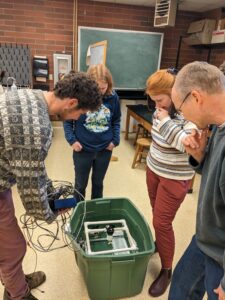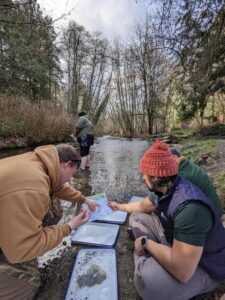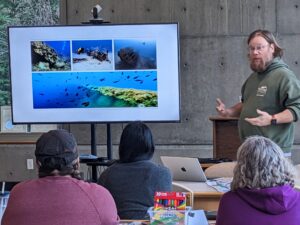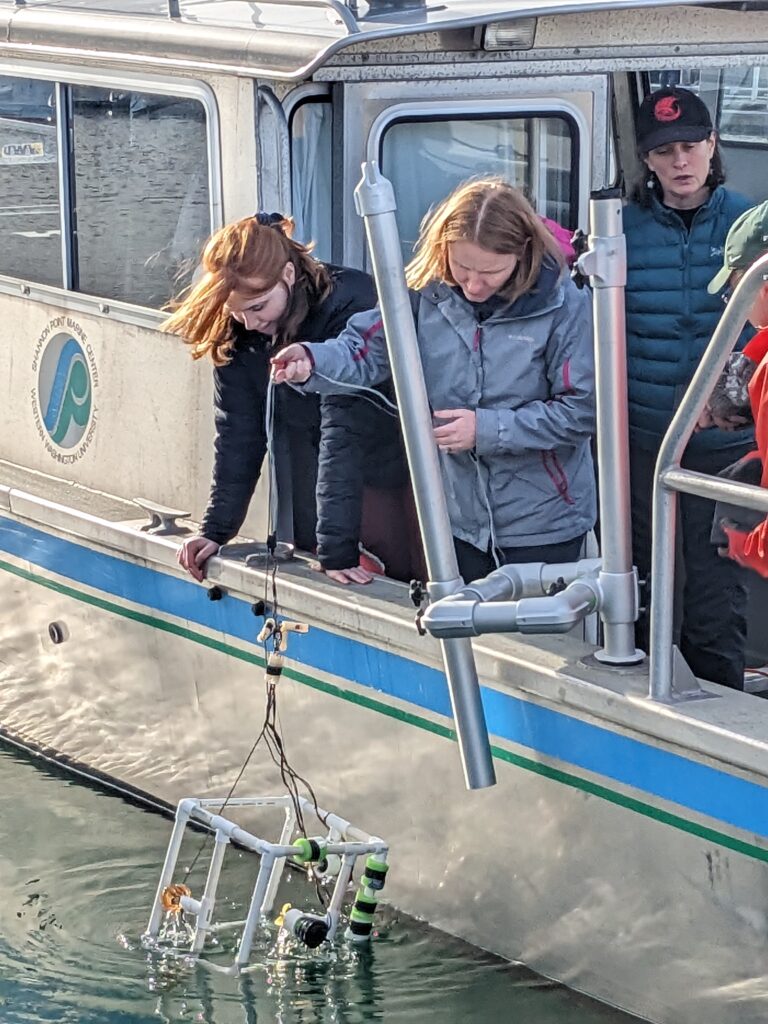You know an event was successful if people are disappointed when it’s over. When PEI’s Explore the Salish Sea workshop wrapped up on February 11th, participants weren’t ready for it to end. “No one wanted to leave,” says Daniel Cuevas, PEI’s East Sound South FieldSTEM Coordinator. “We were at a park, looking at bugs and learning how to use interesting scientific equipment. The time went by fast.”

The popular program migrated to PEI in 2022 and founder Mira Lutz is working with PEI staff to familiarize them with its content. Earlier in January she and Northwest FieldSTEM Coordinator Amy Keiper facilitated another workshop. “It’s such a natural fit with the PEI workshop format,” Lutz notes. “It’s been very smooth and working with Daniel and Amy is a joy.”
In both workshops, participants reviewed the curriculum, came up with a central question and went through a design process that mirrored what their students would experience. In January, the task was to develop a remotely operated vehicle (ROV) that could access marine debris trapped under a dock. The design challenge began with imagining the technology used by Nuu Chah Nulth First Nation shell gatherers 3,000 years ago to gather dentalium, a tusk-like mollusk found on deep, cold and dark seabeds that humans couldn’t access by diving.
“I love the relevance as well as the framework and inclusion of indigenous knowledge and perspectives. I will be sharing my learning with colleagues.”
— Workshop Participant
The groups also heard from guest speakers who shared expertise on a range of subjects. The January workshop featured Coast Salish elder Rosie Cayou, a First Foods knowledge sharer. “She was talking about her work with indigenous science and the importance of managing kelp,” says Keiper. “She shared the cultural importance of kelp to tribal people and the perspective of having a relationship with the land and the services that kelp provides both in terms of the ecosystem and also its social and health benefits to people.”
“I love the relevance as well as the framework and inclusion of indigenous knowledge and perspectives. I will be sharing my learning with colleagues.”
Shannon Point Marine Center Laboratory Manager Dr. Derek Smith was the second speaker, sharing his experiences of traveling the world using ROVs for his research. “He showed some cool pictures from all over the Mediterranean Sea and southwest Hawaiian Islands,” Keiper says. “He talked about the role of his research in learning how to restore coral reefs. It was really helpful for people to make the connection to his work and how to make this career pathway relevant for their students. The type of thinking they used for their little PVC pipe ROV projects is the same thinking used to create his ROVs that are a lot more advanced.”
In the February workshop, the goal was to determine whether the water at Leach Creek was a safe habitat for baby coho salmon hatched from eggs in

school aquariums. The Tacoma Salmon in the Classroom is a collaboration between Foss Waterway, Pierce Conservation District and the Puyallup Tribe in which schools raise baby salmon in large tanks before returning them to the wild. With the tools they learned, teachers can participate in the program and help their students determine which waterways in Pierce County are viable home streams for their salmon.
It was a hands-on process, says Cuevas. “We use different methods of testing the water quality like looking for indicator species of macroinvertebrates. We also did a vegetation survey and a stream survey that measured flow rate, temperature and dissolved oxygen.”
The February workshop also featured guest speaker Clover Park Technical College Professor of Environmental Sciences & Technology Dr. Derek Faust. He explained how the college is increasing equity by preparing students for immediate entry into the workforce upon graduation. “They gain the skills to go out and do technical work for environmental science organizations,” says Lutz. “Through the college, they already have the skills which some people who have Bachelor’s degrees or even Master’s degrees don’t have.”
The other speaker was Lindsay Walker, Community Education Coordinator at Communities for a Healthy Bay. Walker is also a boat captain, educator and captain for Deep Green Wilderness, and Program Coordinator for the Sound Policy Institute at University of Puget Sound. She shared information on her work with resident orcas and right whales and helped participants identify plants during the stream survey. “They are a potential community partner for schools,” Lutz notes. “Communities for a Healthy Bay can help teachers bring their students out to mark storm drains or fish and show them how to do it. They can also just provide the materials for students to mark storm drains in their neighborhoods.”

The combination of exploring the curriculum, hands-on learning and hearing from experts made an impression. “I love the relevance as well as the framework and inclusion of indigenous knowledge and perspectives,” said one participant. “I will be sharing my learning with colleagues.”
Another reported, “I loved this workshop and the hands-on activities. Making the ROV was exciting. I learned so much throughout the process of creating it and look forward to more PEI workshops.”
The Tacoma School District uses the salmon unit of the Explore the Salish Sea Curriculum each year and will continue to do so. Workshop participants who are interested in implementing the curriculum can contact Lutz if they would like guidance. “They can connect with me to ask for support,” she says, “and also if they want to share what they’ve done with the curriculum.”
